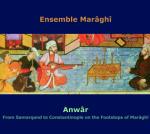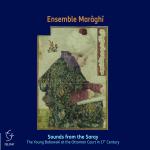Shop

ENSEMBLE MARAGHÎ
Anwâr - From Samarqand to Costantinople on the Footsteps of Maraghî
Fy 8172
885016817220
Felmay Records
Turchia
Anwâr - From Samarqand to Costantinople on the Footsteps of Maraghî
Fy 8172
World Music
885016817220
Felmay Records
Turchia
The Arab term Anwâr (‘splendours, lights, illuminations’) seems to perfectly describe the compositions that are the halt and stages of a musical journey on the footsteps of ‘Abd ul-Qâdir ‘ibn Ghaybi Marâghî (1360? - 1435): he was a musician, a composer and a musicologist who lived along the net of trade routes called ‘Silk Road’. Born in Maragheh, nowadays Azarbayjan-e-Sharqi, Iran, he worked at the courts of Tabrîz, Samarqand, Baghdad and Herât, nowadays Afghanistan, where he left this world. His talents were highly esteemed by emperor Timûr, also known as Tamerlane (1335-1405).
Marâghî wrote his treatises in Persian and his heritage spanned over a vast area thanks to his sons and disciples. Particularly, his compositions were preserved and held in high esteem in the Ottoman world: in fact, by 1422 his Maqâsid al-Alhân was taken as a gift to the Ottoman court of Sultan Murad II in Bursa by his youngest son, Abdülaziz, with a caravan from Herat: Ottomans considered that as the symbolical act that gave life to their classical music tradition.
Ottoman art music from its very beginning has always been deeply linked to Sufism (tasawwuf) and its peculiar spiritual practice called samâ‘ (‘audition, listening, spiritual concert’). For some Sufi brotherhoods (tariqas), the samâ‘ became a central practice on their spiritual path: one of the best known is the one of the brotherhood mevlevîye, known in the West as ‘Whirling Dervishes’, that flourished on the teachings of Persian language Sufi poet Mevlâna Jalâl-ud-Dîn Rûmî (Balkh, 1207 – Konya, 1273). The centres of the mevlevî Dervishes (mevlevîhânes) are considered by scholars as ‘the Conservatories of the Ottoman empire’, that formed the majority of the Ottoman classical composers and musicians active between the Court and the Sufi centres.
The instruments
The setâr (literally, ‘three strings’) is a small Persian long necked lute that is widely played and beloved in Persian classical music. The classical Persian singing style made the human voice ‘the’ instrument in itself, thanks to the highly sophisticated vocal techniques of tahrîr. The reed flute ney is a millenarian instrument, the first traces dating back to 2500 B.C. The instrument acquired a new symbolical role thanks to the fist 18 distiches that open the immortal poem (masnavî-i mathnawî) of Persian language Sufi poet Mevlâna Jalâl-ud-Dîn Rûmî. The term zarb comes from classical Arab term dharb meaning ‘time, measure, beat’. Nowadays its onomatopoeic variant tombak is also widely used: both terms designate a goblet drum. Bendir and dâyre are two kinds of frame drums: Short necked lute ‘ûd takes us again back to the Silk Road: the first traces come from Tajikistan in clay figures of the Ist century B.C., the instrument reappears in North West India and in Persia, under the reign of Shapur I (3rd century B.C.). Following the Silk Road, it appears in China (pipa) and Japan (biwa). The Arabs met and adopted it during their invasion of Persia in 7th century B.C. Through Arabs, from Maghreb, the ‘ûd reaches Andalusia (al-liud, liud), Provence (luth) and Italy, where Dante called it lëuto.
The Ensemble Marâghî
The Ensemble was born at the opposite end of the Silk Road, Venice, Italy, in 2008. During these years our journey has already taken us to many concerts, places and palaces. The core of the Ensemble is a Trio composed by percussionist Francesco Clera, who studies goblet drum zarb (or tombak) with Jâmshîd Shemirânî and his two sons, Bijân and Keyvân as well as with Behnam Samâni. Giovanni De Zorzi, is at the same time an ethnomusicologist (PhD) and a ney flute player who studies with Kudsi Erguner and teach the instrument at the Conservatory ‘Arrigo Pedrollo’ of Vicenza. It seems worthy of note the imminent publication of his: Giovanni De Zorzi, Musiche di Turchia. Tradizioni e transiti tra Oriente ed Occidente. With an essay of Kudsi Erguner, Milano, Ricordi/Universal Music, 2010. Giovanni Tufano studied short necked lute ‘ûd with Lebanese Gazi Makhoul. Young, cultivated and curious singer Sepideh Raissadat is the most remarkable meeting in our journey: she has studied since the age of 8 with many great living masters of the Persian Art music (radîf) tradition, she is musicologist, she already recorded various CD’s and she is unanimously considered as one of the best voices of her generation. Giovanni De Zorzi

Musicians
Giovanni De Zorzi, ney flute (sepürde in 2-5; mansûr in 6-12), musical direction;
Giovanni Tufano, short necked lute ‘ûd; frame drum dâyre in track 12;
Francesco Clera, goblet drum zarb (or tombak), frame drum bendir;
with
Sepideh Raissadat, voice, long necked lute setâr

HQ Image
Our Playlist
Our olaylist on Spotify, dedicated to P
re Minimalism, Minimalism and Post Minimalism.
Search





















